Now & New
- Experience
Bamboo Ohanami Day in Takehara: Rewarding Trek Up the Hill
Did you know that Takehara has the smallest population of any city in mainland Hiroshima Prefecture (only Etajima has fewer people) and the third-smallest land area of all cities (right behind Etajima and Otake) in the prefecture? That being said, Takehara boasts a plethora of noteworthy tourist sites in spite of its small size, meager population, and relative lack of fame, but these points of interest are spread out over a wide area and cannot all be reasonably visited in a single day. While the Historical Preservation District in downtown Takehara may be an easy walk from JR Takehara Station, the infamous “Rabbit Island” of Okunoshima must be accessed by ferry, and renting a bicycle is highly recommended for getting to Matoba Beach or P. Three Home Bamboo Park. The latter is a somewhat isolated hilltop park that can be enjoyed year-round, but a visit in the early spring is without a doubt the best time to go since the countless sakura in and around the park hit their peak the first week of April, turning the whole place into a cherry blossom wonderland.

In addition, the first Sunday in April—which is usually projected to be in the middle of peak season—sees a grand event called Bamboo Ohanami Day happen on the spacious grounds of the park, where Takehara residents and visitors from all over gather to enjoy food and fun amidst the cherry trees. Though a train ride to Takehara may be tedious when approaching from Hiroshima Station, the Kaguya-hime bus line that departs from the Hiroshima Bus Center (with stops at Hatchobori and Hiroshima Station’s Shinkansen Exit) makes the journey just a tad shorter and easier.
Down by the Sea, Up to P. Three
Upon reaching Takehara Station, tourists can immediately enter the Tourist Information Center adjacent to the center building to inquire about renting a bicycle for the day. From here, the P. Three Home Bamboo Park where the festival was taking place is a one-hour walk or an eight-minute taxi ride, but if I simply took a taxi to the festival site, we wouldn’t have much of an article, would we?

Having a bicycle cuts the commute time roughly in half, taking tourists past Matoba Beach and affording stunning seascapes that feature carefree fishers at the pier and ships sailing across the Seto Inland Sea in the distance. Along the way, I passed by Momokichi An, a café where I passed the time eating a small lunch whilst hiding from the deadly summer ultraviolet rays. I was tempted to make a pit stop there so I could make use of the terrace, but I knew I had a festival to attend so I sadly passed up the thought. Not too long after that, I noticed a road sign pointing the way up an incline to the P. Three Home Bamboo Park, at which point I turned left to cross the road and start my way up the hill. Close to the white road sign was a pink temporary bulletin board that predicted the progression of the cherry blossoms, correctly guessing peak season to be April 7th, the exact date of Bamboo Ohanami Day!

The path up the hill was a bit long but not too steep for pedestrians or cyclists, and seeing all the cherry trees on the way to the park pumped me up for the food trucks, live entertainment, and flea market that awaited me at the top. When I came across a wide-open parking lot on my left adorned with carp streamers, I knew that I had reached my destination. It felt a little too early to be seeing carp streamers in early April as most places only set them up during the days leading up the Golden Week, but the piscine wind socks looked rather majestic blowing in the wind as I walked through the parking space towards the park entrance.
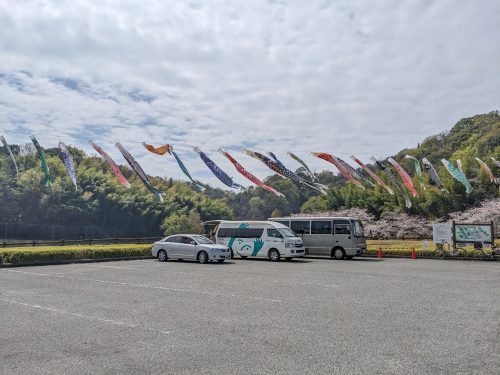
Nature’s Eat Seats
There was no mistake that this was a full-blown festival, with nearly every blooming cherry tree in sight occupied by a picnic blanket or a tent. Thankfully, due to the sheer size of the park, the venue never felt crowded save for the lanes where food trucks and stalls were set up. Every single person at P. Three Home Bamboo Park that day was there to partake in the festivities, and as I saw throughout the day, even those who were slated to perform on stage took out the time to buy snacks and holler at their acquaintances before and after their own shows. The first thing I wanted to do when I entered the park was see who was performing, but before that, I had to quell the rumbling in my tummy so I followed these little dancers in the direction of the stalls.
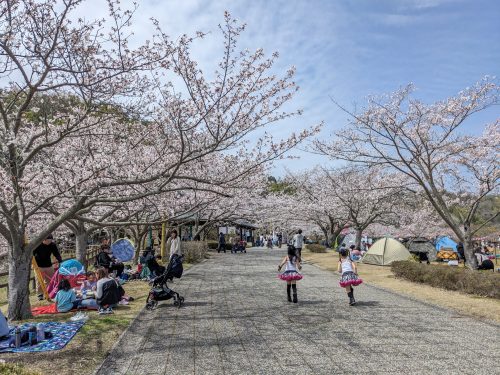
Along the way, I came across the flea market on my right, which had some nifty vintage items like record players and charming clothes from yesteryear. Meanwhile, on my left were a bunch of vendors offering up some tasty choices for an early lunch or midday snack, and I found myself wandering up and down that same path until I finally decided what to eat. The stand pictured below belonged to a local okonomiyaki joint that specializes in Takehara-yaki, which is basically Hiroshima-style okonomiyaki with sake lees inside the batter. In my humble opinion, it doesn’t necessarily taste better or worse than plain old Hiroshima-style okonomiyaki, but as it is relatively more distinct and sort of exclusive to this part of the prefecture, I wanted to give it another go. Demand for Takehara-yaki was naturally high, so I had to wait for a spell while the cook hurriedly prepared everybody’s share. Of course, since the chef is only human (he had to multitask as he was grilling frankfurters and chicken wings too), all these Takehara-yaki halves for sale didn’t end up the same size. When I realized my piece was less than 50% of a regular Takehara-yaki, I expressed my concern to the cashier and the cook whipped up another one to cut correctly and give to me directly, fresh and hot off the griddle.
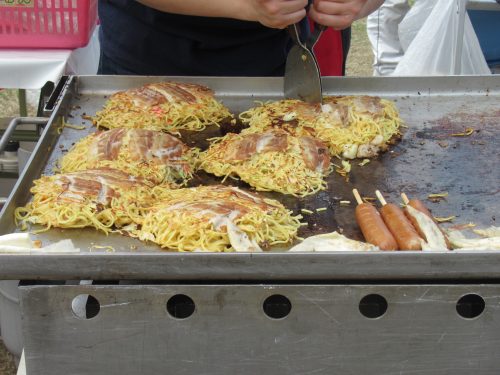
After getting my lunch, I brought it over to Bamboo Joy Highland, the stage area where spectators sat on the ground while eating, drinking, and watching performers strut their stuff. That’s right, the seating area doesn’t have any chairs or benches; rather, there are semicircular “rows” of alternating grass and stone for people to plop their bottoms when watching shows. This setup allows for easier mobility between rows as there’s no need for sidestepping when leaving one’s row, and kids who run all the time can have a field day playing tag or something while their parents sit and view the entertainment. The first performance I saw was a group of elderly folks doing Taijiquan, which I suppose is expected for folks their age. I actually knew this group would take the stage when I got to Bamboo Joy Highland because I saw one of the performers talking to a picknicker as I was ordering my food. I’m always excited to see something not so typically Japanese during what I initially perceived as a traditional Japanese event, and these old women and men exhibited graceful moves, flexibility, and prowess with the jian (劍 – Chinese sword).
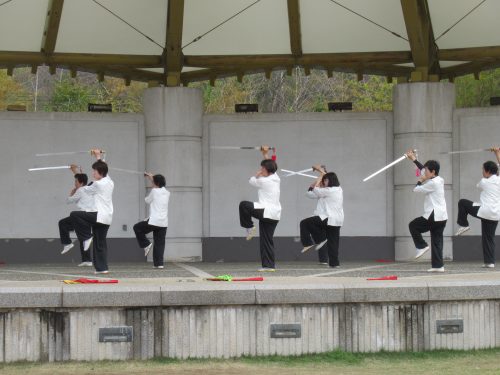
The group that followed them was a traditional Japanese dance troupe, which danced to tunes that sounded over a century old while waving props like sticks, colored fans, and fake cherry tree branches.
The above dance looked more like the stuff I come to expect at Japanese festivals (in addition to the abundance of kids’ hip hop dance schools). After these ladies finished their performance, I got up and realized that the audience multiplied as I was devouring my Takehara-yaki in my natural eat seat. I took that as my cue to leave and check out other parts of the festival and park.
Other Ways to Spend the Day

One half of a Takehara-yaki was definitely not enough food for a grown-up like me, so I found myself walking between the food vendors yet again, looking for a good deal that wasn’t just your run-of-the-mill carnival fare. The good thing about festival food later in the day (at least for festivals that don’t last into the night) is that it tends to go on sale near the end of the festival, so all I had to do was wait another hour or so to pounce on something cheap but worthy of being called a meal. I eventually settled on some tai-meshi (鯛飯 – sea bream rice), a specialty of eastern Hiroshima Prefecture, which I scarfed down while sitting on a nearby boulder. What was neat was that even though I was far away from the stage area, I could still clearly hear and even see the shows going on from that boulder thanks to the park’s layout.
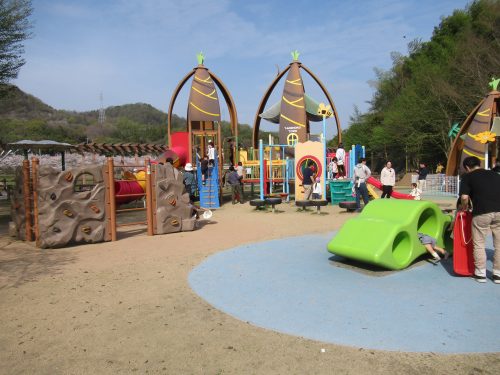
There were other forms of entertainment besides what we saw on stage, such as the usual carnival games for kids like ball-scooping, target shooting, and the drawing of lots. Add on the stands in the flea market—each of which had a plethora of cool curios—and one could spend all afternoon browsing all the different stands at the festival. On top of that, P. Three Home Bamboo Park has a corner with multiple jungle gyms so kids can play here any day of the week. Even though I wanted to play pretty badly, it was a hot April afternoon and I was too tired from walking to the park and pacing between the stands so I just stood there watching the kids go to town on the “Takenoko Town” structure. Most of the little ones were brimming with energy, and it seemed like they could never get enough play time here in spite of their faces that were flushed red with exhaustion.
Moment of Joy: Wii Are Getting Older
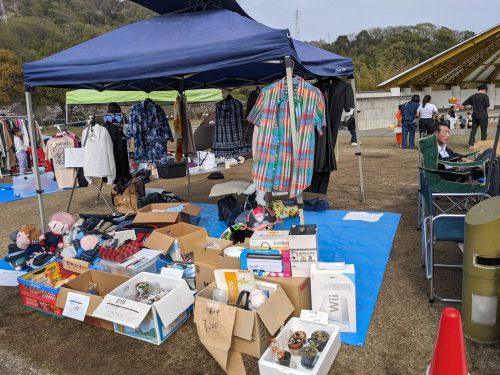
As the festival was drawing to a close, I returned to the flea market one last time just to check out what was for sale (I had no intention of buying anything) when I saw one vendor selling a used Nintendo Wii for only ¥800! My first thought was, “Wiis aren’t antiques, are they?” but then it hit me: the console’s heyday faded over a decade ago. With the owner’s permission, I opened the box and inspected every part inside, and everything was like new, as if the original owners never played with the console. It felt like the deal of a lifetime, so I snatched it up (after paying, of course) and lugged it all the way back to Takehara Station bound for Home Sweet Hiroshima. Using the Wii was the best form of nostalgia I have encountered at any flea market in Japan and has inspired me to shop for more games that remind me of those good old days.
Sakura of Significance
You didn’t think you were going to get to the end of this Takehara-related article without even one mention of the anime Tamayura, did you? Not only did Bamboo Joy Highland make an appearance in the show, but some specific cherry trees from the series have appeared in the real-life counterpart as nerdy Easter eggs, so to speak. The coolest part of the sakura at P. Three Home Bamboo Park is that regular people as well as organizations can have their own tree planted somewhere inside the park with a plaque to identify it. Trees are usually planted to commemorate a special occasion, like the birth of a child or somebody’s graduation, and since names and dates are clearly displayed on the plaque, these special personal memories can easily be shared with the public in the form of pink and white flowers.
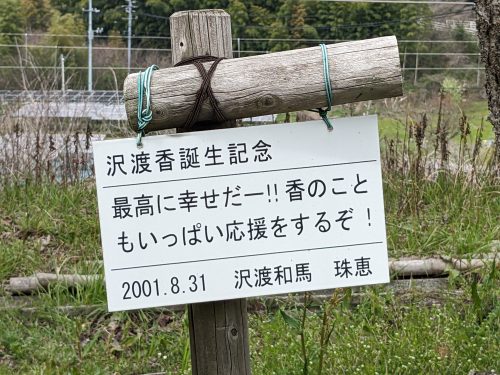

The cherry tree above was allegedly planted to commemorate the birth of Kou Sawatari, the younger brother of Tamayura’s protagonist Fu “Potte” Sawatari whose tree was adjacent to this one. Obviously, the real-life tree belongs to someone else and was planted before the anime aired, but this anime reference was placed exactly where it was located in the anime, which in turn was inspired by this very park. As stated before, sakura can be planted by anyone for any occasion (there’s probably some sort of registration and payment involved), so when Sayomi Hanawa—older sister of Kaoru Hanawa—realized she didn’t have a tree planted for her birth because she was supposedly born before this system was introduced, she planted one herself (pictured below) to celebrate getting her moped license. Sayomi and Kaoru’s trees were also located side-by-side in both the show and real life, and I must say, the illustrators did a tremendous job picking some scenic sites in the park for these trees! All four of these Tamayura trees are located pretty far away from the Bamboo Ohanami Day festival site and require a bit of walking and crossing roads to reach, but any die-hard fan would be willing to make the journey for these so-called anime holy sites.
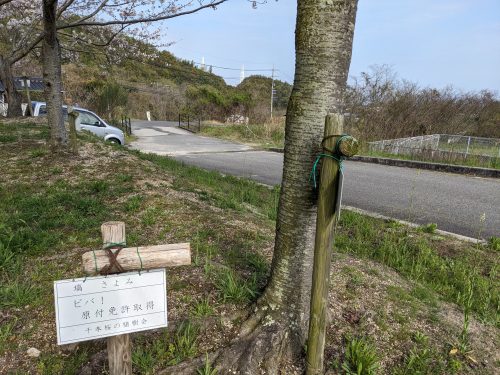
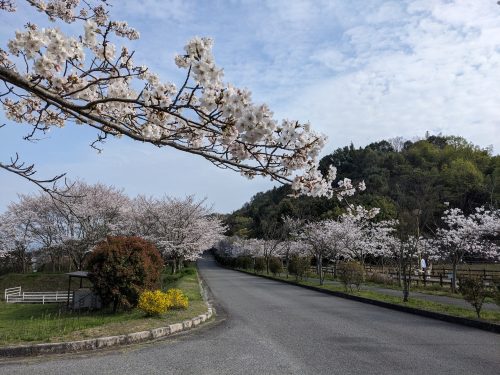
With those pictures all snapped up, the Bamboo Ohanami Day festival officially came to an end, and I began the long journey back down the hill, with my new used Wii occupying almost all the space in my backpack. Tourism options truly expand when one can rent a bicycle, so I think I’ll be trying that more often when visiting small towns like Takehara.
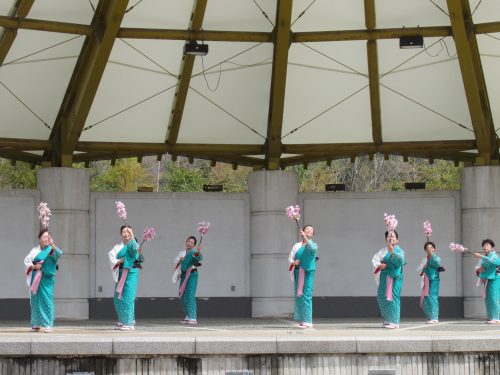
I had wanted to visit P. Three Home Bamboo Park ever since I binged Tamayura a year prior, and I’m so glad I waited until sakura season to see the best side of it. More importantly, I’m grateful that the day of the festival fell during the period that the cherry blossoms were at their most vivid and that the sky blessed us with warm and dry weather that Sunday. If I have the time and energy to do this again next April, I think I will, and so should any tourist that swings by these parts. Though I had to say good-bye at a time I felt was too early, I was already looking forward to my next visit here and possibly my next good buy from the flea market!
Written by the Joy in Hiroshima Team
